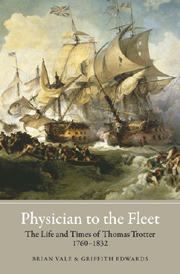Book contents
- Frontmatter
- Contents
- List of Illustrations
- List of Abbreviations
- Foreword
- Preface
- Background
- From Surgeon's Mate to Physician to the Fleet
- The Newcastle Years
- 12 Married Life and Civilian Practice
- 13 An Essay on Drunkenness
- 14 A War of Pamphlets
- 15 A View of the Nervous Temperament
- 16 Physician as Poet and Playwright
- 17 Thomas Trotter and the Great Theatre of Life
- Bibliography
- Index
14 - A War of Pamphlets
from The Newcastle Years
Published online by Cambridge University Press: 12 September 2012
- Frontmatter
- Contents
- List of Illustrations
- List of Abbreviations
- Foreword
- Preface
- Background
- From Surgeon's Mate to Physician to the Fleet
- The Newcastle Years
- 12 Married Life and Civilian Practice
- 13 An Essay on Drunkenness
- 14 A War of Pamphlets
- 15 A View of the Nervous Temperament
- 16 Physician as Poet and Playwright
- 17 Thomas Trotter and the Great Theatre of Life
- Bibliography
- Index
Summary
ON AN AUTUMN DAY in early November 1805, Trotter found himself in Jarrow, then a small village, some 6 miles from Newcastle on the road to South Shields. As he approached St Paul's church he became aware that the burial ground was filled with a multitude of grim-faced people. He paused to watch, and realized that he was witnessing the results of a mining disaster. A fortnight before, on 21 October, underground gases in the nearby colliery of Hebburn had exploded, killing thirty-five mine workers, the youngest aged only sixteen. The tragedy had left twenty-five widows and eighty-one orphans. Funerals of this kind were not, alas, a rare occurrence. In the mining industry the gases that lurked in the depths of coal mines were a constant threat. Miners could be poisoned by the accumulation of carbon monoxide or carbon dioxide, called ‘choke (or choak) damp’, or killed – as in this case – by explosions due to methane, known as ‘fire damp’. Trotter was deeply affected by the scene in the churchyard and returned home determined to do something about it.
The result was a pamphlet entitled A Proposal for Destroying the Fire and Choak-Damp of Coal-Mines. Trotter had originally intended that his ideas should be published as a letter to a newspaper, but he had found that the exposition required a pamphlet-length space. The publication of Trotter's pamphlet was a demonstration of his concern for humanity, but also of his dedication to the Enlightenment principle that science in general should be useful in the public sphere and that chemistry might offer the answer to the recurrent tragedies which were blighting the local coal fields.
- Type
- Chapter
- Information
- Physician to the FleetThe Life and Times of Thomas Trotter, 1760–1832, pp. 175 - 184Publisher: Boydell & BrewerPrint publication year: 2011



